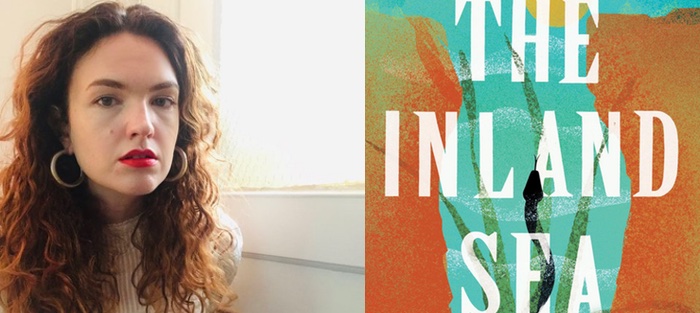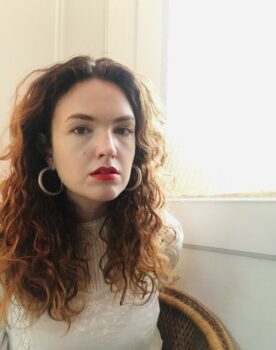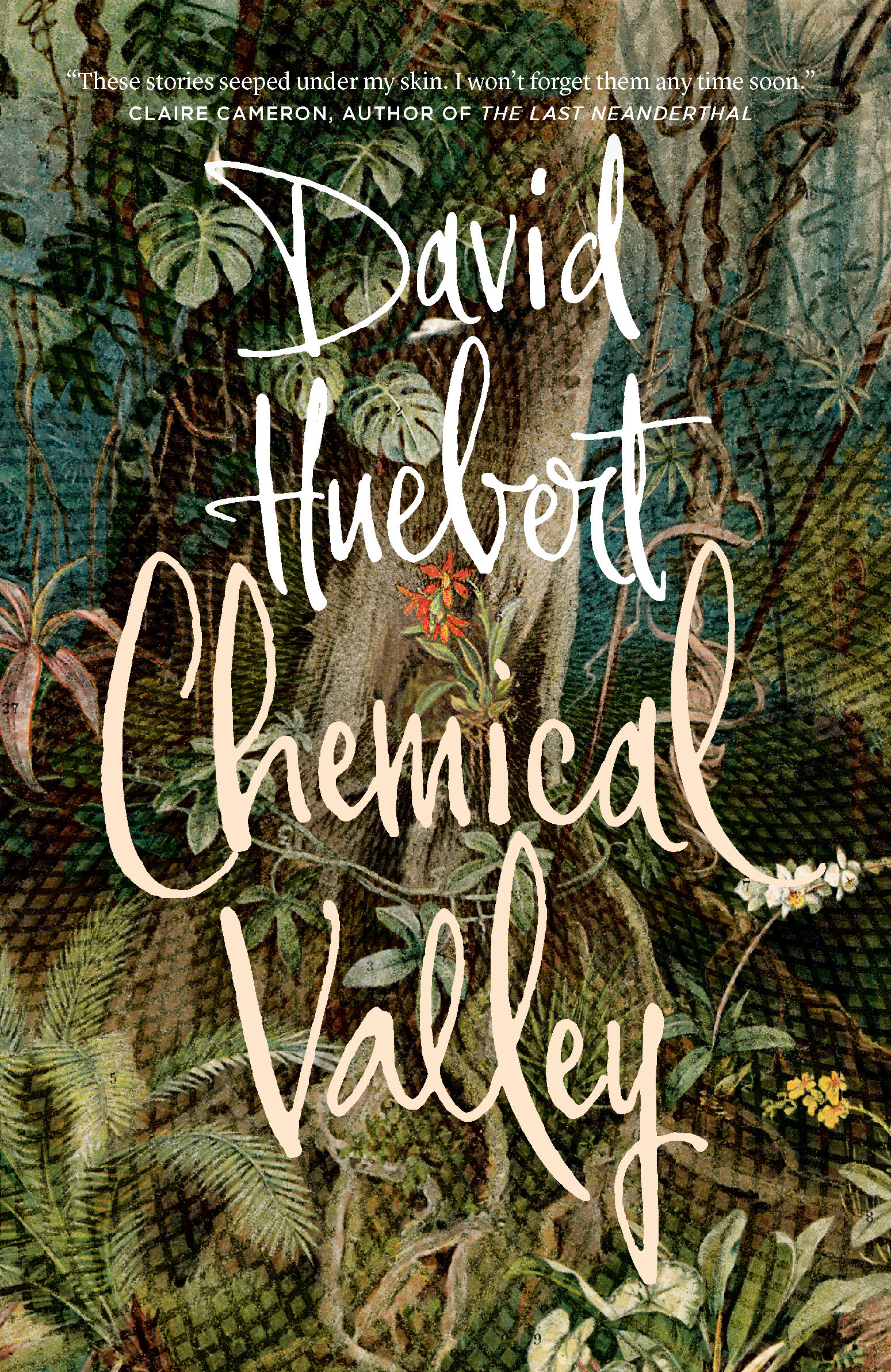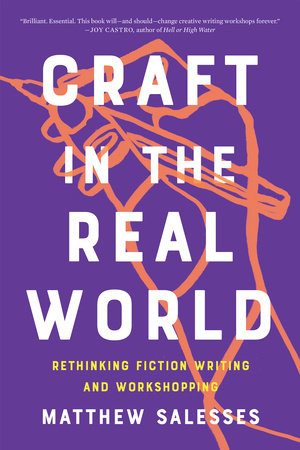One of the key elements of fiction writing is smallness—rendering the subtle tone of voice or the unkind joke—and so fiction may seem to be an inadequate tool for confronting the sheer scale of climate change. But recently, novels like Richard Powers’s The Overstory, Jenny Offill’s Weather, Lydia Millet’s A Children’s Bible, and others have started to find a way to render the lived experience of a changing climate without leaping entirely into cli-fi scenarios removed from the laundry-and-grocery-shopping texture of daily life.
And so I was especially excited to talk with Madeleine Watts, author of The Inland Sea (Pushkin Press/Catapult), about writing in this estuary of climate Before and After. The book follows an unnamed Australian woman navigating the self-doubt and bad relationships of early adulthood while marinating in the anxiety of unending and undefinable weather crises. While working as a dispatcher at the Australian version of 911, we feel along with her the specific consequences of a largely abstract concept, as fires aggravated by climate change advance across the country.
Watts and I spoke on the phone between Brooklyn and Berlin a few days before Joe Biden’s inauguration.
Interview:
Alexander Tilney: It’s hard to talk about this book without talking about pessimism—you are not shying away from the bleak here. It makes me think of the Heinrich Heine poem, Morphine, which ends, “it would have been best not to be born.” Just the most pessimistic thought possible. But there’s irony there simply in the fact that taking the time to render the hopeless in precisely the right way is an act of hope. And still, that interpretation seems coercive: if you want to be fully pessimistic, then you’re strong-armed into optimism by the act of transmitting that view. So I’m wondering how you approached putting across a bleak vision that is also an act of communication, and the creation of something for a reader to live inside of.
When you write a book, you don’t know until you’re finished what it’s going to be, and you don’t have an argument for it when you start out. I didn’t write the book that I started off thinking I was writing. A lot of people have asked me about this question of pessimism, and I don’t quite know how to respond, because I was kind of incorporating ideas that were coming at me while I was writing.
In the structure, in the form of the book itself, I was trying to address the way that we live with the environment, the way that we live with fear and anxiety, and trying to make that both form and content.
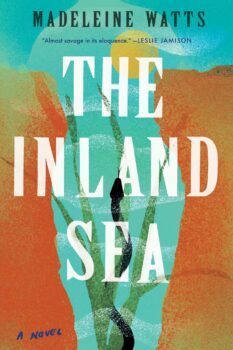 One of the things that was really important to me was to find a structure that was different in order to talk about nature, to talk about climate change. I don’t think that the realist novel or the character arc really works to talk about that. I think those systems really fail us. So this book was taking this one portion of time, this one year, and amping up the volume. I never wanted it to have any sort of sense of redemption, because I think a redemptive narrative is really dishonest when you’re talking about what it is to live in the landscape and the natural world today.
One of the things that was really important to me was to find a structure that was different in order to talk about nature, to talk about climate change. I don’t think that the realist novel or the character arc really works to talk about that. I think those systems really fail us. So this book was taking this one portion of time, this one year, and amping up the volume. I never wanted it to have any sort of sense of redemption, because I think a redemptive narrative is really dishonest when you’re talking about what it is to live in the landscape and the natural world today.
Every engagement we have with nature is fundamentally woven through with climate change, because it’s not something that’s coming, some dystopian future, it’s the present. And so if the ending is pessimistic, it’s because I really wanted to resist any kind of redemption. I didn’t want the character to grow or to change very much. I didn’t want to offer that to the reader because I thought it was dishonest to what the material was.
I also didn’t want to offer a sense of hope when I didn’t feel like there was one. I was really trying to write what it feels like to be alive right now, what it feels like for me to be alive right now: the sense of anxiety and fear that is just threaded through the days. And it turns out that the result of that is some significant pessimism.
Sometimes I had moments when I was writing the book where it was really hard to explain to myself why I was sitting in a room, writing a book and not talking to anyone for most of the day. (And I think this is especially true for everyone who has been involved in any kind of artistic pursuit in the last four years minus a week.) But, not to get too high-minded about it, I also think there is a compulsion to make art that is really human. One of the things that we can cling on to is just what makes us human. So, that act of creation itself feels important.
Also, we’re a week and two days out from the storming of the capital, and in the last week I’ve been reading Ninth Street Women, this group biography of women involved in the abstract expressionist movement. Near the beginning, the book is really setting the context of what it was like to make art during the Great Depression and World War II.
There’s a part towards the beginning that talks about art representing our common humanity. Even when to some minds it feels like the least productive thing you can do, art is actually one of the things that reminds us all that we have souls. [Laughter.] It’s such a high-minded thing to say, and I don’t know if I should even be saying it, but it felt incredibly meaningful last week. I’ve been thinking about it ever since, because there is part of me that really believes that, even as another part of my mind is incredibly cynical. So, I don’t feel like I have a very good answer to your question.
I think that’s the best answer. I think forcing oneself to either side would be dishonest. And I agree with you: I feel like expressing those kinds of larger hopes is almost transgressive. But I think that’s important: a lot of artwork stands in opposition to messengers that are trying to convey false hope—governments and advertisers come to mind.
But just as you mentioned, the form of so much traditional artwork doesn’t really fit very well when you’re talking about climate change. You were talking about the inadequacy of the realist novel, the kind of novel that’s aiming for verisimilitude with lived experience or a kind of fictive dream. In The Great Derangement, Amitav Ghosh talks about the responsibility of writers to not just kind of hide in that realist work that takes a lot of skill to create, but that also dodges and looks away from larger problems that are more important.
And that makes me also really interested in connecting to earlier eras of no hope. How do you make things after the Holocaust and during pervasive doom of nuclear war? In these contexts, when the strict kitchen-sink realist dream is inadequate, do authors edge over into allegory?
There are certain times in The Inland Sea where there’s no shyness about tying this particular character’s lived experience to a larger way of thinking about climate change, or the survival of human beings in general, or the agony of animals. And elements of allegory seem to accomplish that. I find this strategy interesting, because the entire time I’ve been raised as a writer, allegory was kind of set up as the worst possible option, the most inert way of telling a story. But maybe revisiting allegory to see if there’s something that’s interesting there is a possibility, or even a necessity, in the kind of project that The Great Derangement calls for.
Yes, my book is really playing fast and loose with metaphor and allegory for sure. And the character, she’s very leaky to the world. She has no boundaries. And that was a way of depicting her experience, and depicting how I feel sometimes, and I think an honest way of depicting how a lot of people experience the world. Even something as simple as: your day is worse if it’s raining sometimes. You can make things that happened to the landscape feel very personal. But it has nothing to do with you at all. That’s a very human response. We’re going to have very human responses to this human crisis that we’ve made.
Amitav Ghosh was a huge influence on how I thought about the book. He talks about the realist novel not having a lot of room for the improbable. The form doesn’t account for any of that. What you’re looking at is too big. It’s hard to be convincing. He talks about the link to histories of capitalism, and the realist novel being a product of the birth of imperialism as well.
He talks about looking for other ways to tell these stories because the stories just aren’t being told. We say that we’re taking climate change seriously, that it’s the most serious problem that we’re facing. (Or, at the beginning of 2020 you could feel confident saying that.) But now, still, the pandemic is indivisible from climate change, the pandemic was produced by climate change to some extent. But this reality is very absent from a lot of the art that we’re making. I think it’s a problem of how we have been conditioned to tell stories.
I was very interested in playing around with allegory. It felt natural to me to talk about it in that way, the way that weather and impersonal events can feel personal even when you have absolute knowledge that they are not. I was interested in pushing that to its limit, in part to just see what it did, to see where that kind of intensity went. Because one of the other problems if you’re trying to write about climate change is that no one individual really experiences the breadth and the entirety of it. You’ll get bits and pieces, but the way that most of us experience it in our day-to-day lives is reading about it. It’s the bits and pieces of information that flit in and out of your brain and make you very anxious.
But you also have to go to work and you make coffee in the morning and you go about your daily life. You don’t really change much. But still these things kind of infiltrate your head. So I was really trying to talk about the dailiness of that experience, and allegory felt to me like a good way to do that, allegory and metaphor. It’s a way of talking about those barriers. When they do break down and you have those moments of recognition and realization, everything feels as though it’s a part of you. Your body goes beyond itself.
There’s this really wonderful book by Daisy Hildyard called The Second Body. She talks about how your body is not just your own, your body is also everywhere all at once. There’s a communal second body that we all inhabit. So I tried to find a way of talking about all of that at once.
That’s such an interesting way of looking at it. I agree with that critique that the novel is sort of a product of a certain economic model. But also, writing about climate change doesn’t seem to quite fit with like a certain biological model either. The problem is too abstract. When an animal faces a threat—a snake at the opening to the burrow or whatever—that threat is limited in time and space: there is a direct experience and bounded conflict. But when instead you encounter this haze of a problem, you almost feel like you’re the wrong kind of animal or kind of perceiver to experience the conflict, even before you try to communicate about it.
And so I agree that there’s something key in looking at the boundaries of your body, conceiving of yourself not just as your ego (whose drives got us into this mess), and not even just as this isolated biological animal, but also as a kind of larger organism that each of us is a smaller part of.
And that brings me to the emergency call center in the book. That place seems to create some connection between the main character and the people calling in, but it also emphasizes that separation of that self from others.
The job of taking emergency calls hooks her into all these situations that the narrator suddenly has knowledge about but no control over. It’s almost the negation of the Serenity Prayer. Which makes it so apt as a way to talk about climate change: you know about a thing but you can’t control that thing. The call center becomes almost allegory but also a place of regular everyday experience. Does that make sense with your intention in writing about the call center?
I can tell you about how I arrived at the call center as a good of method of talking about all of this. I did a ton of reading for the book, and there were two big trilogies that I read sort of incidentally as I was writing the book. One was John Dos Passos’s USA trilogy, and the other one was Eduardo Galeano’s Memory of Fire trilogy. I recommend both of them so highly.
The structure of both those books was playing on my mind as I wrote my own. They’re both incredibly ambitious portraits. Galeano is telling the history of the Americas from prehistory up until he stopped in the 1980s. Dos Passos was trying to write the sweep of America in the early 20th century. I wanted to take something from their structures, the way they accommodate a multiplicity of voices. That felt important to me as a way of getting into a lot of the thoughts I was having about climate change.
So, I actually did work at Triple Zero [Australia’s equivalent to 911]. That’s the most non-fictional part of the book. None of the calls are based on actual calls that I received. But in the beginning of writing the book, I had written a couple of scenes of the call center, not really knowing what they were going to do. I just started writing this character and she needed a job. So I gave her a job that I had had. And then I realized after doing several drafts of it and working on it for a while that it was a way of bringing the world in and having her experience the world. And the book is interested in different types of emergencies and what being in an emergency does to people.
And my experience at that call center was that you never heard a full story. You never had a resolution. You didn’t even get the beginning and you certainly didn’t get the end. You just got the highest point of intensity. Every single person you talked to—and you could talk to fifty people in an hour, maybe more—they were all having one of the worst days of their lives.
When I was working there I was constantly attuned to that level of intensity. It was really horrible and really disorienting. But as I started writing about the call center, years later, I realized that it provided a kind of narrative structure to introduce a multiplicity of voices. So in the book, you have this one character who is intensely in herself, and in a very specific place in Sydney, and the call center allows her to go all over the country and to experience lives that are not hers, to experience emergencies that are not hers. To have her be the receptacle for all of it.
Dos Passos has a section in his trilogy called the camera eye. I wanted those call center sections to be able to zoom out in a similar way. So even though the narrator has no perspective, and the narration stays very close to her, she can narrate the world around her, and she can deliver information as though she’s reporting on it.
The call center is also a concrete way to represent an abstract concept. Many of the emergency calls that the narrator hears are run-of-the-mill of emergencies, but so many of them are a culmination of the effects of climate change. Especially with the fires toward the end, these calls are where the disaster of climate change is coalescing.
Yeah.
You say “Yeah” in a way that makes it seem like you want to trouble that or question it.
I think it is a coalescing to some extent. It’s just really hard to write about any one natural disaster because of the problem of having to have a character. The character has to be more of a protagonist than the landscape is. And part of climate change is that the weather is very much the protagonist. The big climactic event that happens towards the end of the novel, which is the only one that the character ever experiences, is the big fire. But, of course, the only thing that actually individually happens to her is she sees smoke over the city and it’s really eerie. And she knows from growing up in that city that it’s too early for fires.
But because it’s conveyed through a chorus of voices calling in, you get the orchestra of that particular weather moment. But if you focused in on any of those individual experiences—while they’re incredibly important and horrible experiences—they don’t narrate that weather event. There’s still the need to go deep down into one individual experience. There’s a really lovely book that I read after I finished this book called A Constant Hum, by Alice Bishop, which is about the terrible Black Saturday bushfires in Australia in 2009. They’re all short stories about people who were involved in the fires, and through their accumulation you begin to get a real sense of what that weather event was like.
I think A Constant Hum is a really good example of climate change literature: it isn’t dystopian and isn’t sci-fi. It’s a portrait of the real event. You have the full impact of the fires from a chorus of voices. It’s a way of writing the weather event as the protagonist.
I’m going to keep pursuing the topic of allegory a bit here. This particular character’s drive to safety causes so many problems that lead to, for lack of a better description, her lack of safety. She’s drawn to the guy she’s sleeping with, Lachlan, because he provides a feeling of safety, but their dysfunction pretty badly erodes her safety. At the risk of making too much of a parallel, that seemed to provide a way to write about very human drives to safety that cause so much harm: getting from place to place very quickly, heating the places we live, digging metal out of the ground to make the machines we’re talking to each other on right now.
This is another question I’ve been asking myself, because like many people I am also drawn to stories about harm, there is innate drama there. But I’m wondering if it’s possible to find drama in stories about nourishment. Can stories be about good choices? Is it possible to write about that without being moralistic or Pollyanna-ish? Typically, when writers or musicians, say, find religion, the work doesn’t often get more interesting. And I really am not saying that this kind of work would try to point out bad behavior and try to lead a reader to a better place, not at all. But can a writer compellingly portray the experience of someone, you know, growing plants?
Yeah, I think so. A lot of the books that I derive the most pleasure from and were big influences on this book are a kind of experimental creative nonfiction that has come to prominence in the last twenty years. And nature writing, both recent and not. I was reading a lot of histories of American environmental thought. I was also reading Thoreau and Emerson for the first time.
And a lot of that nature writing, whether it’s old or new, it is just someone growing plants, and it’s beautiful. I love stories like that.
One of the books that I really loved when I was writing this book was The Wall by Marlen Haushofer. It’s a book about a woman and a dog, the details of their day-to-day life, except that the end of the world has happened and she’s trapped in the Alps. She doesn’t really know the details of the end of the world, there just seem to be no more people, and she’s got a dog and she has to learn how to build a fire. And it’s wonderful. There is at once quite a lot of drama and nothing happens.
I’m really interested in those kinds of stories, and I do think they’re worthwhile. But also when you’re taking the perspective of just one individual and the choices an individual makes, is that enough? To go back to the Daisy Hildyard book, there is a way of looking at the second body, the macro body, as well as the micro body, which expands the idea of what an individual is, what they can encompass. When you’re talking about that, you’re also talking about the ways in which the body inhabits histories and economics and ecology, and all of these narratives that run through us. So there’s no story you can tell about someone just planting plants and going for a walk that isn’t also very complicated and threaded through with the world they live in, the culture that produced them, their class and race and gender position, the products they consume, the bad choices they’ve made.
So I think it’s possible to tell those stories, but I also think that I’m not interested in those stories without that kind of range, the ability to zoom in and out on the person in their own day-to-day, and the person as they’re situated in the whole, wide world.

